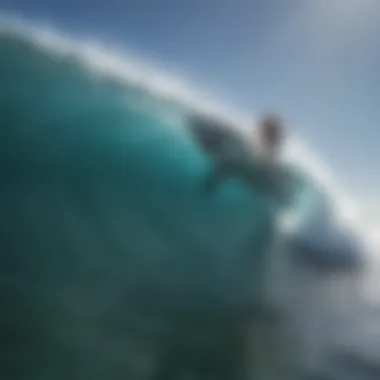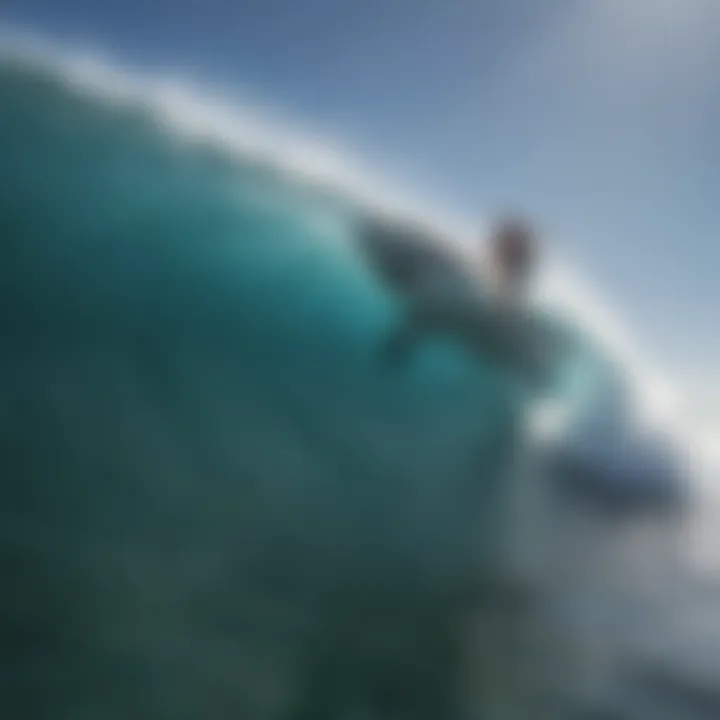Exploring Shark Bands 2: Enhancing Surf Safety


Intro
Surfing has always danced on the edge between thrill and trepidation. With every swell comes excitement, but beneath the waves lurks a reality surfers must face—sharks. As the surfing community grapples with safety, technological innovations have entered to change the game. One such innovation is Shark Bands 2, which aims to enhance safety in the water by repelling sharks through sophisticated technology. This article digs deep into the principles behind this device, its effectiveness, and its broader implications for surfing enthusiasts.
As surfers, we have a deep connection with the ocean, and that connection can sometimes be fraught with danger. While enjoying the magnificent waves, one cannot ignore the risks presented by marine life. Shark Bands 2 seeks to bridge the gap between adventure and caution, presenting a tool that claims to diminish those risks.
In this exploration, we also reflect on the cultural nuances of surfing, the responsibility that comes with it, and how we must navigate our passion for the sport alongside the realities of environmental awareness. Join us as we chart a course through the intersections of safety, technology, and the surfing experience itself.
Preamble to Shark Bands
In the world of surfing, the thrill of catching waves often intertwines with the underlying concern about shark encounters. The importance of discussing Shark Bands 2 lies not just in the technology itself but also the peace of mind it offers surfers. With advances in shark safety tech, surfers can better appreciate their time on the water without the lurking threat of a shark incident.
Understanding what Shark Bands 2 brings to the table is essential for surfers, instructors, and eco-enthusiasts alike. This article aims to clarify the significant elements and benefits of these devices. Shark Bands 2 utilizes innovative technology that repels sharks effectively, allowing surfers to focus on their passion rather than anxiety.
The consideration of using Shark Bands opens up a broader conversation about safety innovations in surfing culture. As awareness towards environmental concerns grows, incorporating such technology aligns with responsible ocean use.
Understanding Shark Bands
Shark Bands operate on the principle of electromagnetic fields, designed to disorient and repel sharks. The core of this technology is its ability to create a frequency that's offensive to many shark species. By wearing these bands, surfers can create a protective boundary, reducing the likelihood of an encounter with these magnificent ocean dwellers.
There is a growing interest in these devices among surfers, not only for safety but also for their role in facilitating a fun and worry-free experience on the waves. The bands promise a unique combination of science and practicality, making them an essential gear item for anyone passionate about surfing.
The Evolution of Shark Safety Technology
The shark safety technology journey has progressed significantly over the years, shifting from rudimentary methods to high-tech solutions. Traditionally, surfers relied on simple measures like avoiding murky waters or times when sharks were known to gather. However, the advent of Shark Bands shows a turning tide in proactive shark management.
Earlier devices intended to deter sharks often fell short. They might have provided some level of comfort, yet the actual efficacy was inconsistent. With Shark Bands, though, we see an evolution that offers not just theoretical safety but credible scientific backing.
As surfing continues to surge in popularity globally, prioritizing safety through technological advancements becomes paramount. The evolution from mere avoidance strategies to innovative deterrents highlights a commitment to both safety and the love for surfing. Embracing such changes underscores the surfing community's adaptable nature and its dedication to respecting the ocean and its predators.
The Science Behind Shark Bands
Understanding the science behind Shark Bands 2 is crucial for surfers who truly want to grasp how this technology works to enhance their safety out on the waves. By examining the principles behind shark repellent devices, the mechanics of electromagnetic interference, and the research validating their effectiveness, one can better appreciate the innovation at play while navigating the ocean.
How Shark Repellents Work
At their core, Shark Bands use a unique approach to keep sharks at bay. They are designed to emit an electromagnetic field that interferes with the electro-sensitive cells located near a shark's snout known as the ampullae of Lorenzini. When these cells detect electric fields, they help the sharks locate prey. Thus, by creating a disruptive electromagnetic environment, Shark Bands aim to mislead sharks, effectively making surfers less recognizable as potential prey.
The application of this concept isn't just some flashy gimmick. It's grounded in years of research exploring fish and predator interactions in aquatic ecosystems. The bands are strategically crafted to maximize the coverage area of the electromagnetic field, which enhances their effectiveness. Users often describe the sensation as a low hum, those who’ve tried them note that it can be an odd feeling at first but leads to a greater sense of security.
Understanding Electromagnetic Interference


Electromagnetic interference (EMI) isn't just a buzzword; it's the foundation of how Shark Bands function. In simple terms, EMI occurs when an electronic device emits signals that disrupt the normal operation of nearby electronic devices or biological systems.
Sharks have long relied on their acute senses to survive. The ampullae of Lorenzini cover their snouts like a finely-tuned radar. By using electromagnetic fields, Shark Bands disrupt this radar, leaving the sharks unsure and disoriented. It's akin to trying to listen to your favorite song while someone cranks up the static on the radio. The familiar signals are replaced by confusion, which for a shark, could mean it's not worth the risk to approach.
This interference factor underscores the importance of proper usage—meaning positioning the band correctly on one's own body can maximize its efficacy. Besides, it’s an intriguing blend of marine biology and technology that redefines the experience of surfing.
Research and Studies Supporting Effectiveness
Several studies have been conducted to evaluate the effectiveness of shark repellents, including Shark Bands. A range of marine biologists and researchers have observed behavior changes in shark populations exposed to these devices. In many trials, results indicated a decreased presence of sharks in experimental zones where electromagnetic fields were present.
"Research indicates that sharks are less likely to approach areas where electromagnetic fields disrupt their natural hunting abilities."
One notable study featured controlled environments where sharks were monitored during the introduction of these electromagnetic bands. The findings not only supported the claim that these bands can repel sharks but also sparked discussions on broader implications for safety and ocean conservation. Further, anecdotal evidence from surfers around the world reinforces the idea that when equipped with Shark Bands, surfers feel an additional layer of protection.
Overall, while more research could undoubtedly help refine this technology, the existing body of work already paints a promising picture for a technology that may soon become a standard in surfgear—enhancing experiences while prioritizing safety.
User Experience with Shark Bands
The phrase "user experience" often pops up in tech discussions, but when it comes to a product like Shark Bands 2, it carries a weight that goes beyond just usability. For surfers, a smooth interaction with safety technology is essential—not only for peace of mind but also for enhanced performance in the water. Other than merely keeping sharks at bay, it's about contributing to a culture of safety without compromising the thrill of surfing.
Surfer Testimonials and Reviews
Real experiences from surfers out in the field provide a unique perspective on how effective Shark Bands 2 really is. Many users rave about the reassurance they feel when paddling out, particularly in waters known for shark activity.
- Safety First: One surfer noted, "I was always a bit on edge every time I hit the waves. Now, with Shark Bands, I feel like I can focus on my ride, not the lurking potential of danger."
- Performance Impact: Others have pointed out that they have yet to notice any hindrance in their usual surfing styles. For example, a longboarder observed, "I didn’t think wearing the band would feel natural, but honestly, I forget it’s there!"
- Mixed Reactions: However, not all feedback has been positive. A few reviewers have mentioned instances where they still spotted sharks nearby, leading them to question the bands' effectiveness—even as they noted that feeling secure in the water was a definite step up.
This mix of reviews underscores an important point: individual experiences vary widely.
Market Response and Adoption
When a product hits the market that bridges safety and performance, especially in the surf community, the response can be quite telling. With Shark Bands 2, the initial reaction in surfing circles has been worth noting. Retailers from coastal towns to online marketplaces have seen a noticeable uptick in interest.
- Increased Demand: Shops specializing in surf gear are reporting that Shark Bands are flying off the shelves. Interest is not limited to professional surfers; weekend warriors and even novices are eager to embrace the tech.
- Community Discussions: On forums like Reddit, conversations about the bands have sparked debates on their effectiveness. Some members share personal accounts while others seek scientific backing to form a more educated opinion. This engagement within the community demonstrates a collective curiosity not merely about the technology but about maintaining a safe ecosystem in which surfers can enjoy their sport.
- Social Media Buzz: Many surfers take to platforms like Facebook and Instagram to showcase their experiences with Shark Bands 2—posting pictures and videos that highlight both the beauty of surfing and the importance of safety.
Overall, it’s clear that Shark Bands 2 has tapped into a broader conversation about safety in surfing. No longer a niche topic, this technology is impacting the entire surf culture, necessitating an ongoing dialogue between users, experts, and environmentalists alike.
Considerations for Surfers
Surfers, like any thrill-seekers, stand at the crossroads of adrenaline and safety, and there’s no denying the importance of understanding the tools they use, such as Shark Bands 2. This device promises to enhance safety while keeping those who ride the waves confident and carefree. However, surf safety isn't just about having the right gear; it also involves a mindset and approach towards the ocean and its inhabitants. By honing in on key elements such as best practices, limitations, and the unique challenges posed by the environment, surfers can truly optimize their experience while mitigating risks.
Best Practices When Using Shark Bands


To maximize the benefits of Shark Bands 2, surfers should keep several best practices in mind:
- Familiarize Yourself with the Product: Before hitting the waves, ensure you have a solid understanding of how Shark Bands work. Many users may overlook reading the manual or consulting online resources. Knowledge is power, and being well-informed can boost confidence.
- Proper Placement: For the device to work effectively, understanding how to properly wear or position the Shark Band is crucial. Whether it's on the wrist or the ankle, maintain a tight fit to avoid it slipping off during those intense rides.
- Regular Maintenance: Regularly check the battery life and functionality of your Shark Bands. A worn-out battery may compromise its effectiveness.
- Combine with Awareness: Shark Bands should not be a crutch. Always maintain situational awareness about your surroundings. Even with the best technology, the ocean remains unpredictable.
- Communicate with Fellow Surfers: Share your experiences and insights with your surf buddies. This creates a culture of openness, allowing everyone to learn from each other's encounters and making use of technology together.
Limitations and Challenges
Despite the promising advancements offered by Shark Bands 2, there are some noticeable limitations and challenges that surfers must reckon with:
- Not Foolproof: While Shark Bands aim to repel sharks, they cannot guarantee complete safety. Many factors contribute to shark behavior, and no technology can eliminate risks entirely.
- Dependence on Technology: There's a tendency for users to rely heavily on the technology. This could lead to complacency regarding safety practices. Surfers should not let the presence of Shark Bands make them disregard their instincts and traditional safety measures.
- Limited Range: The effectiveness of the electromagnetic field created by Shark Bands may diminish with distance. This means that if sharks are outside the range, the device won't have any impact on them.
- Environmental Impact Concerns: Some surfers express concern about the potential impact such devices may have on marine life beyond the target species.
"While these devices provide a layer of reassurance, it's essential to never underestimate the ocean's temperament. Respect and awareness go hand in hand with equipment usage."
By balancing the advantages of technology with judicious practices and a respect for the ocean, surfers can enjoy a more confident experience while testing their limits. The integration of Shark Bands 2 into this nuanced landscape of surfing ultimately reflects a deeper awareness of both safety and the natural world.
The Role of Safety in Surf Culture
In the world of surfing, safety isn't just a checkbox on a list; it's woven into the very fabric of the lifestyle. Surfers are typically thrill-seekers, drawn to the ocean's wild waves, yet an undercurrent of risk always exists. With Shark Bands 2 at the forefront of many discussions, the need to balance exhilaration with mindfulness of safety has never been more pronounced.
The integration of safety technologies, particularly those addressing shark encounters, reflects a shift in mindset within the surfing community. Once dominated by the bravado of seeking adventure against all odds, there’s been a gradual but significant transition towards responsible surfing. Surfers today understand that while they may flirt with nature's unpredictability, they can also arm themselves with tools that enhance their safety. Shark Bands, for instance, are not just a product; they're a cultural response to an age-old fear that many surfers share.
It's important to recognize that these technologies have implications that reach beyond personal safety. They also advocate for a greater awareness of environmental stewardship. Many surfers are now keenly aware that their sport exists within a delicate ecosystem. As such, using products designed to protect them also opens doors for conversations about marine biomes and the impact of human activity on wildlife.
Evolving Perspectives on Shark Encounters
The narrative surrounding shark encounters has evolved remarkably over recent years. In the past, tales of close calls with sharks would often surface as near legends among surfers, charged with adrenaline and heavy doses of bravado. Now, as safety technology like Shark Bands gains traction, conversations have shifted significantly.
Shark encounters, once seen as merely perilous and threatening, are increasingly viewed through a lens of cooperation and respect. Surfers are beginning to see themselves as part of a broader community, one that includes marine life. The mentality is changing from one of conflict with nature to understanding the role of sharks in the ocean's ecosystem. This move toward a more educated standpoint fosters a sense of responsibility in how surfers behave in the water.
"We aren’t just conquering waves; we’re engaging with an ecosystem we need to respect and understand."
The stories being shared now are less about survival and more about informed participation in the ocean's grandeur. Many surfers are using social media platforms like Reddit and Facebook to share experiences and advice, highlighting not only their adventures but also their learnings about safe practices and environmental considerations. These new narratives encourage others to engage positively with the ocean while remaining vigilant against potential dangers.
Environmental Awareness and Responsiveness
There’s no doubt that the rise of shark repellents and safety technologies promises peace of mind for surfers, but what about the responsibility that comes with this newfound confidence? As surfers become more equipped to deal with the dangers of the ocean, there’s a parallel expectation that they also engage with the environmental issues surrounding them.
Surfers, often considered guardians of the coastline, have a unique platform from which to speak on marine conservation. Their adventures provide firsthand insight into changes in ocean conditions, marine life populations, and the effects of pollution. Shark Bands 2 and similar products serve not only as protective devices but as symbols of a conscientious effort to exist harmoniously with nature.
In embracing advanced technologies, surfers are also called to promote environmental awareness. They can integrate simple yet effective practices, such as:
- Reducing plastic use to lessen ocean pollution.
- Participating in beach clean-ups and conservation efforts.
- Advocating for marine protected areas.


Adapting to such practices reflects a broader responsiveness to the environmental challenges facing our oceans today. Increased safety should result in enhanced respect for the ocean, driving surfers to become proactive stakeholders in sustaining the very playground they indulge in. It’s about creating a culture where surfing safety and environmental integrity go hand in hand, culminating in a surfing tradition that respects its roots while looking toward a sustainable future.
Future of Shark Repelling Technologies
As the ocean remains a vital playground for surfers, the future of shark repelling technologies holds a significant place in both safety and surfing culture. Innovative devices like Shark Bands 2 are proof of how technology can adapt to our changing understanding of marine life and human interaction. The prevalence of shark encounters has heightened awareness around surfing safety, prompting advancements that aim not just to preserve our lives but also to maintain harmony with the natural world.
These technologies promise innovative solutions that cater to not only the practical concerns of surfers but also the larger ecological sensitivities. As the surfing community increasingly prioritizes safety, it's crucial for these developments to not only be effective but also to align with the ethos of responsible surfing and environmental preservation.
Innovations on the Horizon
In the realm of shark repelling technologies, numerous exciting innovations are on the horizon. These focus on enhancing the efficacy of deterrents while ensuring they are environmentally friendly. Here are some of the key advancements:
- Smart Sensors: Utilizing marine data, future devices may implement sensors to assess shark activity in real-time, allowing surfers to make informed choices about when and where to surf.
- Biomimicry: Following nature’s lead, companies are exploring designs that mimic the sounds or behaviors of predator species effective at deterring sharks. This could lead to more innovative, less invasive methods of shark repulsion.
- Wearable Tech: Building on the concept of Shark Bands, expect more refined wearables that integrate seamlessly into surfers' gear without compromising performance or comfort.
“As we navigate advancements in technology, the goal remains clear — to create a safer surfing environment while respecting the ocean's delicate ecosystem.”
These innovations could pave the way for a future where technology and nature work together more effectively to keep surfers safe.
Integrating Technology and Surfing Culture
Successful integration of technology into surfing culture isn't merely about safety; it's also about fostering a deeper respect for the ocean. As tech-savvy products like Shark Bands become fixtures in the lineup, surfers might need to re-evaluate their relationship with the water.
The symbiotic relationship between tech and culture can be observed through:
- Community Engagement: As new technologies emerge, surfers often form communities around these practices, sharing experiences and advice. This fosters a culture of safety awareness and encourages responsibility among surfers.
- Sustainable Practices: There's a growing trend to develop eco-friendly technologies. The surf culture, historically linked to environmental advocacy, aligns well with innovations that minimize harm to marine ecosystems.
- Education And Awareness: With each advancement, there's an opportunity to educate not just surfers, but the general public about marine life and ecosystems. Knowledge of oceanic behaviors can empower surfers to make safer choices.
As these technologies develop, it will be crucial to maintain an open dialogue within the surfing community and consider the ethical implications of their use. Striking a balance between enjoyment and responsibility will continue to define the surf culture of the future, paving the way for generations of surfers who demand both excitement and safety in their ocean adventures.
Ending
In summing up this exploration of Shark Bands 2, it becomes clear that we are standing at an intersection of technology, safety, and surf culture that has significant implications for every person who loves the ocean. As surfers face risks associated with shark encounters, understanding the technology that can enhance their safety becomes non-negotiable. Shark Bands 2 represents a leap forward, employing advanced technology to proactively tackle this age-old anxiety among surfers.
Implications for Surfing Safety
The integration of Shark Bands 2 into surfing represents a paradigm shift in not just our approach to personal safety, but also our understanding of the ocean's dynamic environment. By utilizing electromagnetic technology, these devices can repel large predators and potentially prevent dangerous encounters. With statistics suggesting that shark-related incidents, while still rare, cause significant concern, Shark Bands 2 provides a tangible solution that could bring peace of mind to many surfers. The implications for surfing safety are vast:
- Enhanced Confidence: Surfers may feel more emboldened to explore new waters, knowing they have an additional layer of safety.
- Educated Choices: The availability of such technology encourages informed decisions regarding when and where to surf, fostering a deeper relationship with the ocean.
- Community Trust: The collective adoption of safety innovations like Shark Bands can shape community norms, leading to increased trust and accountability among surfers.
"There's something empowering about surfing without fear of a shark. It's like adding wings to your board!"
Looking Ahead: Safety and Sustainability in Surfing
As we chart the course for future surfing innovations, the emphasis must shift towards a holistic approach focusing on both safety and sustainability. The technology in Shark Bands 2 is just the beginning; its integration into the surf culture paves the way for more sustainable practices. By repelling sharks rather than harming them, these devices underscore a growing awareness of marine conservation. Surfers can promote environmental stewardship while simultaneously protecting themselves.
- Research and Development: Future innovations could harness more eco-friendly materials and technologies, minimizing impact on marine life.
- Community Initiatives: Surfing communities can launch programs that educate users on responsible surfing practices alongside technological use, creating a well-rounded approach to ocean safety.
- Stronger Advocacy: The ongoing dialogue between surf technology and ecological awareness can encourage local initiatives that protect ocean habitats, creating a ripple effect that benefits surfers and marine life alike.
By fostering an engaged and informed surf culture, we not only protect ourselves but also cherish and preserve the very waters that give us life.















